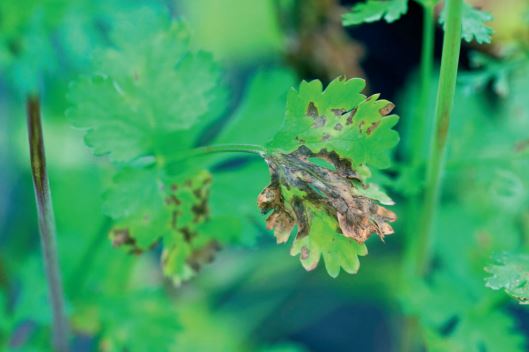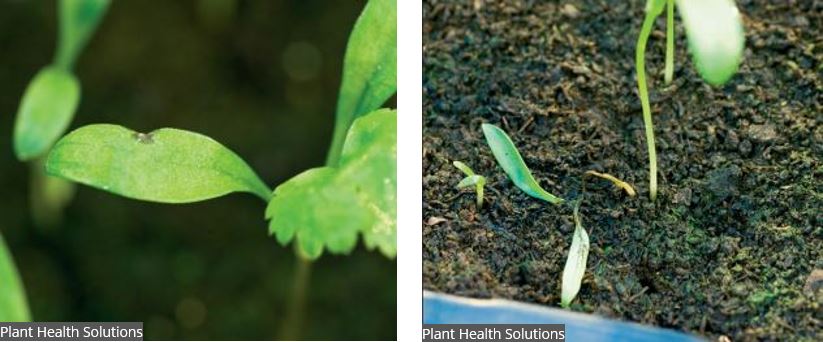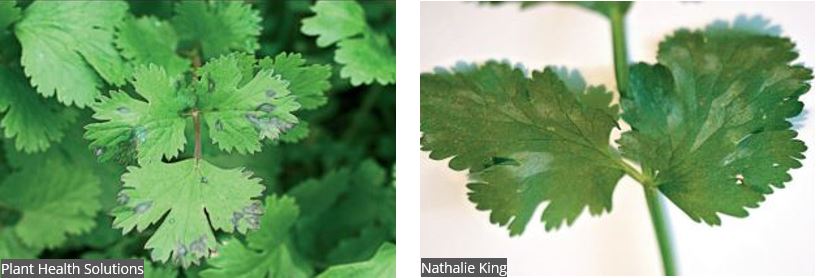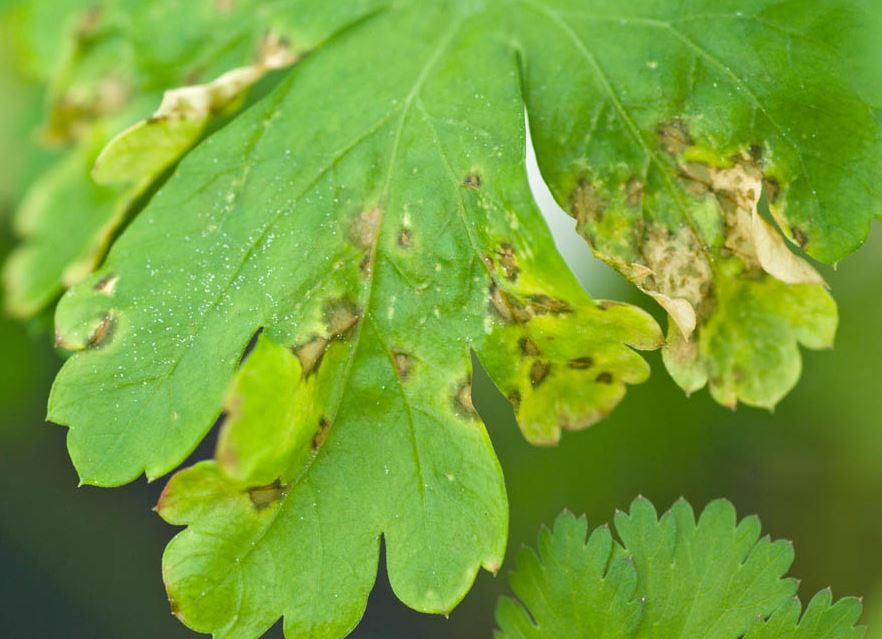Please click here to access the main AHDB website and other sectors.
- Home
- Knowledge library
- Bacterial blight of coriander: symptoms and biology
Bacterial blight of coriander: symptoms and biology
This page provides details of the symptoms and biology of bacterial blight of coriander caused by Pseudomonas syringae pv. coriandricola.
This information was last updated in 2023.
Symptoms
Lesions may occur on all plant parts, and initially appear as dark brown/black necrotic spots with a water-soaked margin (Figure 1).
 Plant Health Solutions
Plant Health Solutions
Figure 1. Typical brown necrotic leaf lesions caused by Pseudomonas syringae pv. coriandricola. Stem lesions are also visible to the left and right.
Infected seeds may fail to emerge. Early infections on seedlings and cotyledons are difficult to spot (Figure 2), and can lead to seedling death (Figure 3).
Leaf spots are often angular, delimited by veins (Figure 1), and clearly visible when viewed from both sides of the leaf. As they develop, and depending on conditions, individual lesions may coalesce into larger ‘blighted’ areas. Individual spots may be surrounded by chlorosis (yellowing) and severely affected leaves also show yellowing and premature senescence. As they age, leaf spots may develop a pale tan centre with a darker margin.

Figure 2. Dark water-soaked lesion on a cotyledon caused by Pseudomonas syringae pv. coriandricola.
Figure 3. Seedling collapse as a result of infection by Pseudomonas syringae pv. coriandricola.
On plants grown for seed, stem lesions may result in collapse; on infected flowers, petals may become brown and fall prematurely. Water-soaked lesions can develop on the green unripe fruit; these can later become dark and shrivelled.
The disease can be confused with physiological disorders such as ‘oedema’, ‘blue spot’ or ‘tip-burn’, so it is important to obtain an accurate diagnosis. A characteristic feature of both ‘blue spot’ (Figure 4) and ‘oedema’ (Figure 5) is that unlike bacterial blight, the lesions are only apparent when viewed from the upper leaf surface.

Figure 4. Blue spot symptoms are only visible on upper leaf surface.
Figure 5. Oedema symptoms are only visible on upper surface of leaf.
Parsley can also be infected and shows similar symptoms to those seen on coriander (Figure 6). These symptoms can easily be confused with septoria blight.
For more information on disease symptoms caused by other pathogens, see the Herbs Best Practice Guide.
 Plant Health Solutions
Plant Health Solutions
Figure 6. Symptoms on parsley leaves caused by Pseudomonas syringae pv. coriandricola.
The pathogen
Leaf spot of coriander is caused by the Gram-negative rod-shaped bacterium Pseudomonas syringae pv. coriandricola (Psc). Early reports of the disease did not identify the pathogen precisely but indicated that it was a strain of Pseudomonas or Pseudomonas syringae.
It was formally proposed as a distinct pathovar by workers in Germany in 1996, with a host range limited to coriander, lovage (Levisticum officinale) and lady’s lace (Ammi majus). Since then results from the USA, and confirmed in the research project FV 403, indicate that it can also infect parsley and celery.
Infection and disease development
The bacterium can survive on leaf surfaces and infects via natural openings such as stomata and via wounds, and can spread through the vascular system.
Precise conditions for infection and disease development have not been established, but coriander bacterial blight is considered a disease of cool, wet weather.
Once inside the plant, bacteria multiply and symptoms develop when populations reach high levels. The speed at which symptoms become apparent depends on a range of factors, especially temperature.
A single infected leaf may contain up to a billion bacteria (109), but even before symptoms become visible there may be as many as a million bacteria (106) in a single lesion. These can be released rapidly once a leaf becomes wet. Thus symptomless plants can be highly infectious well before symptoms are apparent.
Epidemiology
Seeds
Seeds are the primary source of inoculum and means of long-distance dissemination.
Work at the National Vegetable Research Station in the 1970s showed that the disease was seed-borne. This was confirmed in later studies in Germany and Australia. Tests on coriander seed lots from several different seed companies done as part of the Research Project FV 318, confirmed the presence of Psc in some seed lots, with infection levels as high as 5%. In a recent AHDB study (CP 191) three out of four seed lots tested were found to be infested.
Using dose-response data from glasshouse experiments the ‘one-hit’ probability of transmission has been estimated as 0.00018; this is the probability that a single bacterium on a single seed will be transmitted to the resulting emerged seedling.
Spread
Most local (within-crop) spread occurs by water-splash, irrigation, or wind-driven rain, but anything that moves within and between crops (people, animals, insects, equipment, machinery) can potentially spread the bacterium, especially in wet conditions. It is important to be aware that considerable numbers of bacteria may be present and significant spread may have already occurred before any symptoms are seen.
The rate of disease spread from a single primary infection was quantified as part of the Research Project FV 318. Inevitably it varied depending on the weather conditions during the trial period. In the worst case, spread resulted in disease incidence of up to 30% by eight weeks after sowing.
Field carry-over
There has been no specific work to examine the survival of the pathogen in the field in the soil or in crop debris. By analogy with seed-borne diseases of other crops caused by similar pathovars of P. syringae long-term survival in the soil/field is unlikely.
Crop debris and residues from a previously infected crop may provide an inoculum source over the short-term, especially within a growing season, and particularly if the rate of debris breakdown is limited by dry or cold conditions.
Useful links
Research Project FV 318: Integrated management of parsley Septoria and coriander bacterial blight
Research project FV 403: The potential of the coriander bacterial blight pathogen to infect parsley
Research project CP 191: Bacterial Pathogens of UK Crops
Download the original 2012 factsheet on Coriander bacterial blight
Author
Dr Steven J. Roberts, Plant Health Solutions Ltd., Warwick, UK.

